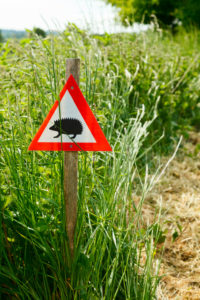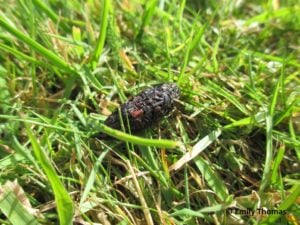
Almost one-third of the UK’s hedgehog population has vanished within the last two decades. But there are lots of initiatives to protect them. Let’s familiarise ourselves with these lovable mammals and how to protect them.
They waddle, huff and puff. They’re nocturnal, they hibernate in winter and roll into a ball as a defence. Their spikes make them unmistakable, and their eyesight is terrible.
Unlike other less charismatic species, the humble hedgehog (Erinaceus europaeus) is the subject of many conservation campaigns and studies, from the Hedgehog Street project, by the British Hedgehog Preservation Society (BHPS) and People’s Trust for Endangered Species (PTES), to The Woodland Trust, The Wildlife Trusts and RSPCA.
In fact, it’s “widely recognised as the UK’s most popular wild animal”, according to PTES. In 2013 it topped a BBC Wildlife Magazine poll to become the natural emblem for the UK1.
Even so, like so many wild animal species on our planet — (we’ve lost half of the world's wild animals in the last 40 years2) the humble hedgehog is under threat.
Below we talk about:
- Hedgehog numbers in decline
- Protection by law
- champions, officers & surveys
- Ways you can help
- How to monitor hedgehogs
Another population in decline
There may be fewer than one million hedgehogs left in the UK3, compared with around 1.5 million just over two decades ago4. It's thought the UK hedgehog population has declined by 30% since 20025. Other reports claim6 hedgehog numbers have declined by half since 2000.
The truth is, no-one really knows how many hedgehogs are left because of their solitary and nomadic nature, which makes them notoriously hard to monitor. The depletion of their numbers (which is happening faster in rural locations than urban) is largely due to four factors, according to The State of Britain’s Hedgehogs 20187:
 Destruction of Habitats
Destruction of Habitats
The destruction and fragmentation of hedgehogs’ natural habitats are due to changes in agriculture (intensive farming methods, land-use change) and urbanisation (more paving, fewer foraging areas in gardens, and more fences). The over- or under-management of hedges, an increase in field sizes can lead to the loss of entire hedgerows, which are an important source of food, nesting and protection from predators, as well as acting as corridors for movement.
Loss of prey
The widespread reduction in the abundance and diversity of invertebrates is also to blame. This reduction can be a direct result from the use of chemical treatments, such as insecticides and molluscicides, or an indirect result through the reduction of plant diversity and loss of habitat, such as hedgerows.
Predation
Badgers (Meles meles) are the main predators of hedgehogs. Badger numbers have actually increased in recent years, although it’s not thought this contributes to the decline of hedgehogs — hedgehogs are declining severely in parts of the country with low badger densities8, such as East Anglia. But badgers also compete for food, such as worms and beetles, as do other invertebrate-eating animals.
On the roads
Around 100,000 hedgehogs are estimated to have been killed on rural roads due to increasing speed limits and lack of lighting, according to the 2018 report by PTES and BHPS.
Protected by law
It is illegal to capture, mistreat or kill hedgehogs (using certain methods) and public bodies have a duty of responsibility towards them, according to UK law9.
Hedgehogs are:
- listed in 2007 as a Biodiversity Action Plan ‘priority species’
- partially protected under the Wildlife and Countryside Act (1981) and the Wild Mammals Protection Act (1996)
- also listed as a ‘Species of Principal Importance’ under the Natural Environment and Rural Communities Act (2006)
Sadly, none of these laws prevents the primary drivers of their decline.
Hedgehog champions, officers and surveys
There are more than 800 known wildlife rehabilitators that take in hedgehogs. The Hedgehog Street campaign has recruited 47,000 Hedgehog Champions. And, in 2013, it created its first Hedgehog Officer role. During their collective history, PTES and BHPS have launched a few surveys which have measured hibernation, population sizes in urban green spaces and the number of hedgehog deaths on our roads.
The Wildlife Trusts are also raising funds across the country via their adopt-a-hedgehog programs. Each adoption costs around £25 and provides the gift buyer with a soft toy, various fact sheets and other related items. Funds raised by the charities go to supporting important local wildlife conservation work.
Hedgehogs are under threat, but PTES and BHPS say that things could improve if we keep improving garden habitats and connectivity while monitoring numbers. Farmers and landowners can help, too, although many already take a sustainable approach to agriculture and receive funding from the Countryside Stewardship Scheme10 to that end. But, says PTES and BHPS in their guide, Helping hedgehogs on your land8, “if hedgehogs are to thrive in our countryside they need a sustained effort from all of us”.
Hedgehog-friendly actions that can be taken by farmers include increasing the density, connectivity and size of hedgerows and field margins, using no-till or conservation agriculture systems, and retaining areas of scrub and decaying vegetation.
Seven ways to help
There are so many simple ways we can all help hedgehogs11 and this doesn’t mean buying expensive equipment. As well as the seven suggestions below, here is also a comprehensive guide to the care and protection of hedgehogs written by UpGardener.
Hedgehog highways
Collaborate with your neighbours to build a hedgehog highway12 by cutting 13cm2 (5in2) holes in your fences or digging a channel or tunnel underneath walls. Hedgehogs need to roam far and wide for food and mates, so this helps them get about. You can buy an eco hedgehog hole plate13 to protect your fence (and any shoddy DIY!). Some also include hedgehog signs to remind owners not to block the gap. (There are also red triangle hedgehog signs for roads, reminding drivers to take care of hedgehogs crossing).
Make, build or buy a home
The simplest way to make a habitat is to create a natural feature out of a compost heap or pile of logs or leaves in a quiet, undisturbed corner of your garden. You can build a hedgehog house (hibernaculum) for a hedgehog. There’s a handy poster here with lots of information about building homes from the Wildlife Trust14, and another from Hedgehog Street15. Or you can buy one of many hedgehog houses, domes, homes or nest boxes16 that are available. Reputable brands to watch out for include Hogilo, Hogitat and Schwegler.
A hogbox should be around 40cm wide, 30cm tall and 26cm deep. Ideally, use untreated wood and no paint. Put a rock on top of the main living area of the box, but don’t screw the roof down so you can clean it in late March. To predator-proof, your hogbox, add a tunnel 13cm square (as in the Hedgehog Street link above).
Make your garden safe
We can do this by avoiding the use of slug pellets, covering drains and gulies, and making a ramp or steps at the edges of ponds for them to climb out.
Remember, remember
If you’re building or lighting a bonfire, spare a thought for hedgehogs. Don’t build a bonfire on top of a log or leaf pile as hedgehogs like to build their nests here. Always check it before lighting, and, if possible, build it on the day it’s going to be lit (to reduce the chance of nesting overnight).
Keep it wild
Growing a wide variety of plants, and letting your garden grow wild, are the best ways to help lots of wildlife, like solitary bees. For hedgehogs, it’s about creating homes for their prey, so make sure your garden has lots of mulch beds17, wood piles and/or leaf litter as that’s where all these invertebrates live, like earthworms, woodlice, earwigs, centipedes, beetles and leatherjackets18 (the larval stage of crane flies or daddy-longlegs).
Feeding stations
You can set up a DIY feeding station by cutting a hedgehog-sized hole in a plastic storage box and weighing the lid down with bricks to stop larger wildlife from getting at it. Inside, put some cat and dog food, shop-bought hedgehog food or chopped boiled egg. Also, put down a bowl of water. Don’t feed them milk, bread or fish. Hedgehogs will only eat around 100g of pet food per night. You can also buy a feeding station19 and some special hedgehog food, as part of this hedgehog Haus protection pack20.
NB Don’t feed hedgehogs mealworms21 as their main diet. Mealworms are high in phosphorous and low in calcium. If you only feed these to hedgehogs, they may develop metabolic bone disease as their bodies try to normalise the phosphorous by taking calcium from stores in their bones.
Rescue & care of a sick hedgehog
If you see a hedgehog out in the daytime or during winter it’s probably in distress. If you find a sick or injured hedgehog11 you should contact the BHPS straight away. They may direct you to a local sanctuary/shelter. Or, wearing gardening gloves, gently place it in a high-sided cardboard box lined with newspaper or a towel (so it can hide) and keep it in a quiet, warm place. You can provide water and meaty dog or cat food, but don’t feed it directly.
Then call the BHPS on 01584 890 801 for some advice and to see if there’s a local rescue centre.
Monitoring hedgehogs
Because of hedgehogs’ nocturnal wandering habits, it’s hard to spot them. But we can still monitor and track them using their footprints, poo and other signs. Here are a few ways to discover their presence:
- Hedgehogs are noisy, so you may hear them if you go into your garden at night and listen, especially in spring when they mate or fighting over females.
 They make tell-tale tunnels in undergrowth and trails through the grass. Look out for these in the morning dew.
They make tell-tale tunnels in undergrowth and trails through the grass. Look out for these in the morning dew.- Look out for hedgehog poo, which is 5-5cm long, dark brown-grey or black22 and packed with invertebrate exoskeletons.
- Hedgehog footprints look like little human hands, but only four of their five toes show up on the tracks. One way to capture their prints, which are about 2-5cm x 2.8cm, is to leave a small, soft area of mud or sand23. To brush up on hedgehog prints, you can buy a pack to identify mammal tracks and signs24.
- To get a little more scientific, simple tracking tunnels can be made from commercially available plastic. They contain a removable tracking plate that contains two ‘ink’ strips, an area for bait and two sheets of paper to record the footprints. This PTES guide for detecting hedgehogs using footprint tracking tunnels25 tells you everything you need to know, from methodology to timing and DIY construction to buying Mammal Society footprint tunnel26.
- To get even more serious, set up some trail cameras27 to spot hedgehogs at night.
You can also buy a gift-boxed starter pack28 for protecting hedgehogs in your garden, which includes a shelter box, snack bowl, hedgehog guide and hedgehog food.
Here's a sum-up of ways to welcome hedgehogs into your neighbourhood in another handy poster29 from Wildaboutgardens.org.uk, via The Wildlife Trusts.


